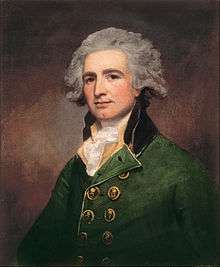Robert Abercromby of Airthrey
General Sir Robert Abercromby GCB (21 October 1740 – 3 November 1827), the youngest brother of Sir Ralph Abercromby, was a general in the army, appointed Knight of the Order of the Bath, a Governor of Bombay and Commander-in-Chief of the Bombay Army and then Commander-in-Chief, India.
Sir Robert Abercromby | |
|---|---|
 Robert Abercromby painted in 1788 by George Romney | |
| Born | 1740 |
| Died | 1827 (aged 86–87) |
| Allegiance | |
| Service/ | |
| Rank | General |
| Commands held | Bombay Army Indian Army |
| Battles/wars | French and Indian War American Revolutionary War Third Anglo-Mysore War |
| Awards | Knight Grand Cross of the Order of the Bath |
Military career
Abercromby served in the French and Indian War, and was promoted captain in 1761. In 1773, he was promoted to lieutenant colonel of the 37th Regiment of Foot. During the American Revolutionary War, he fought at the Battle of Long Island, the Battle of Brandywine, the Battle of Germantown, the Battle of Crooked Billet, the Battle of Monmouth and at the sieges of Charleston and Yorktown, where he commanded the left wing of the British forces. He commanded a battalion of light infantry for most of the war.
After the war, he was made Colonel for life of the 75th (Highland) Regiment, a regiment newly raised to deter the French in India. Abercromby served in India from 1790–1797, where he was Governor of Bombay and Commander-in-Chief of the Bombay Army and then, from 1793, Commander-in-Chief, India.
He was promoted lieutenant-general in 1797, elected M.P. for the county of Clackmannan in the place of his brother Ralph in 1798, and was made governor of Edinburgh Castle in 1801—a post he held until his death—and a general in 1802. His increasing blindness - arising from an eye disease contracted before his return from India in 1797 - made it impossible for him ever again to take active service, and obliged him to resign his seat in parliament in 1802.[1]
Abercromby's niece married James Alexander Haldane, and Abercromby subsequently bought the estate of Airthrey, Stirlingshire from J. A. Haldane's brother Robert Haldane, who was selling his estates to pursue evangelical and missionary work. Sir Robert died at Airthrey in November 1827: aged 87, he was the oldest general in the British army. He was succeeded by his nephew, Lord Abercromby, the son of his elder brother, Sir Ralph.
References
- Robert Abercromby History of Parliament Online article.
External links
| Military offices | ||
|---|---|---|
| New regiment | Colonel of the 75th (Highland) Regiment 1787–1827 |
Succeeded by James Dunlop of Dunlop |
| Preceded by William Medows |
C-in-C, Bombay Army 1790–1793 |
Succeeded by James Stuart |
| Preceded by Charles Cornwallis |
Commander-in-Chief, India 1793–1797 |
Succeeded by Charles Morgan |
| Preceded by Lord Adam Gordon |
Governor of Edinburgh Castle 1801–1827 |
Succeeded by The Duke of Gordon |
| Political offices | ||
| Preceded by William Medows |
Governor of Bombay 1790–1792 |
Succeeded by George Dick |
| Parliament of Great Britain | ||
| Preceded by Sir Ralph Abercromby |
Member for Clackmannanshire and Kinross-shire 1798–1802 |
Succeeded by William MacLean-Clephane |
.svg.png)
